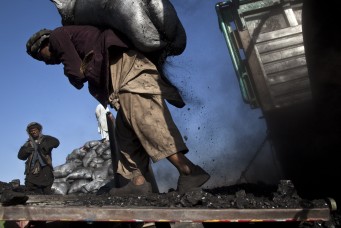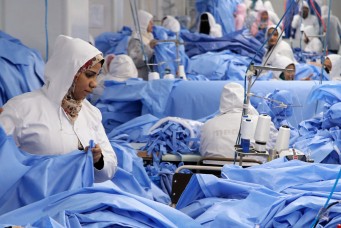Egypt: An Economic Growth Success, yet a Health Failure?
Amid relatively successful long-term economic growth, Egypt still needs to address lagging health issues.

The Egyptian economy has been brought into crisis by the disruption of COVID-19 and the Russia-Ukraine war’s impacts on tourism and wheat prices. In a crisis, it is easy for observers and policymakers to lose sight of the big picture.
In recent years, Egypt has overtaken Algeria, Jordan, and Tunisia to become the third richest Arab country outside the Gulf Cooperation Council (GCC), behind Libya and Lebanon. The immediate cause of Egypt’s climb in income rankings within the Arab World is the stagnation of these other Arab economies. The long-term cause is the impressive, though not spectacular, growth of Egypt’s Gross Domestic Product (GDP) per person over the five decades from 1970 to 2020. Egypt’s GDP per person quadrupled during this period. Of the 112 countries with World Bank GDP per person data covering this period, only fifteen grew faster than Egypt. Two-thirds of these are in East, Southeast, and South Asia, most notably China, Indonesia, and India.
GDP per person is used as the indicator of income because it provides the most broad and reliable international comparisons, but it is important to note that it only indicates average income, not distribution.
Increases in health typically go hand-in-hand with increases in income, yet Egypt has the third shortest life expectancy of any Arab country outside of sub-Saharan Africa, after Yemen and Iraq. Three Arab countries—Algeria, Morocco, and Oman—had lower life expectancies than Egypt in 1970 but now have higher life expectancies in 2020, despite Egypt’s more rapid macroeconomic growth during this period. Over these five decades, Egypt increased its life expectancy by twenty-one years—no mean feat—but Algeria, Morocco, and Oman increased their life expectancies by thirty-one, twenty-five, and twenty-seven years, respectively.
As such, the likely causes of the disconnect between Egypt’s income and life expectancy are worth exploring. Our exploration will lead to innovative policies that can at least partly address the disconnect and are within Egypt’s administrative and budgetary capabilities.
Health is Human Capital
Egypt’s impressive economic growth has been generated by a diversified economy. In 2019, prior to the disruption of COVID-19, Egypt earned foreign exchange in roughly equal dollar values from tourism, manufacturing, and natural resources (agriculture and fossil fuels), supplemented by Suez Canal revenues. The single most important source of foreign exchange, however, is remittances from Egyptians working abroad, mainly in the GCC. In 2019 these were comparable in value to all of Egypt’s exports of physical goods.
Although Egypt’s economic growth has been a success story to date, it is slowing. As Egypt enters the ranks of middle-income countries, it must increasingly rely on the skills of its workers for economic progress, whether these are used domestically or abroad. As a result, human capital will be all-important, and health is the foundation of human capital. In short, health is not only important in its own right but critical to Egypt’s future income growth.
For all countries, the first step to improve health is to control infectious and parasitic diseases by vaccinating the population and eliminating disease vectors. Egypt has taken this first step. In 2019, prior to the impact of COVID-19, Egypt’s death rate from infectious and parasitic diseases was lower than that of all North African countries other than Tunisia. Control of infectious and parasitic diseases was the key to raising Egyptian life expectancy from fifty years in 1970 to seventy-one years in 2020.
The next step to improve health is to reduce deaths from the main killers of adults, which are cardiovascular diseases and cancer. Here Egypt has faltered. For the population of sixty- to sixty-nine-year-olds, Egypt’s death rate from cardiovascular diseases and cancer in 2019 was the highest in the Arab World. For the population of fifty-to fifty-nine-year-olds, among Arab countries only Somalia and Yemen had higher 2019 death rates from cardiovascular diseases and cancer than Egypt.
To this dismal record can be added cirrhosis of the liver, the third largest killer of Egyptians sixty to sixty-nine and fifty to fifty-nine after cardiovascular diseases and cancer. This is mainly the long-term result of a hepatitis epidemic that was inadvertently caused by reuse of injection needles during Egypt’s campaign to suppress the parasitic disease schistosomiasis. Egypt was able to almost eliminate hepatitis C as part of its “Hundred Million Healthy Lives” campaign launched in 2018, and as a consequence Egypt’s death rate from cirrhosis of the liver should fall sharply in the future.
Health Risk Factors and Policies to Mitigate Them
Egypt’s exceptionally high death rates from cardiovascular diseases and cancer become less mysterious when one takes into account certain risk factors such as air pollution, obesity, and smoking. These risk factors and the policies designed to address them should be assessed in the context of Egyptian poverty. Ideally, these policies should be complemented by a comprehensive medical evaluation of all causes for the high rates of cardiovascular diseases and cancer in Egypt.
Poverty relative to average income
There exists a well-known “diminishing returns” relationship between income and health: the same increase in income yields a larger increase in health for the poor than for the rich. Given the average income in a country, then, a “Robin Hood” transfer of income from the rich to the poor will increase average life expectancy. In this sense a high poverty rate relative to average income constitutes an additional risk factor for many diseases—cardiovascular diseases and cancer among them.
Despite continued growth in average income, poverty in Egypt has soared in recent years. Causes include the massive currency devaluation of 2016, the COVID-19 disruption, and the current economic crisis with skyrocketing inflation and further sharp currency devaluations. However, one should not put too much weight on the impact of Egypt’s recent crisis on its poor health performance, given that Algeria, Morocco, and Oman had already passed Egypt in life expectancy by 2015.
In 2015, 13.2 percent of Egyptians had incomes under $3.65 per day, adjusted for purchasing power—the middle World Bank poverty line. This poverty rate was high by the standards of comparable Arab countries. Data is scarce, but we do have observations using the same World Bank poverty line for Algeria in 2011, Morocco in 2013, and Tunisia in 2015. Algeria and Tunisia had average incomes only slightly greater than Egypt’s during those years, yet only four percent of Algerians in 2011 and 2.2 percent of Tunisians in 2015 had purchasing power parity (PPP)-adjusted incomes under $3.65 per day. Moreover, despite the average income in Morocco in 2013 being thirty-five percent lower than in Egypt, 9.8 percent of Moroccans had PPP-adjusted incomes under $3.65 per day in that year—still less than Egypt’s 13.2 percent.
Though this dataset points to poverty relative to average income as a partial explanation for Egypt’s disappointing health performance, an exclusive focus on poverty would miss other sky-high risk factors that link directly to cardiovascular diseases and cancer in Egypt. These other risk factors can be at least partly reduced by policy, even if poverty rates remain high. I will concentrate on policies that are realistic, both in terms of cost and administrative capacity, and then assess how these policies could interact with current government efforts to reduce poverty.
Particulate air pollution
Fine particulate matter (suspended particles measuring less than 2.5 microns in aerodynamic diameter, or PM2.5 for short) reaches the lungs rather than being filtered out by the upper respiratory system, and enters the bloodstream from the lungs. It is considered to be the most dangerous form of air pollution. PM2.5 exposure increases the risk of two cardiovascular diseases (strokes and ischemic heart disease) and three cancers (trachea, bronchus, and lung).
Exposure of Egyptians to PM2.5 air pollution is the sixth highest in the world, according to 2017 data on average population exposure in 167 countries. Notably, two of the five countries with greater exposure are Qatar and Saudi Arabia. This suggests that, for Egypt, desert dust is a major contributor to PM2.5 air pollution, along with the usual culprits such as automobile exhaust. Indeed, a study of Giza in 2013-14 found that the highest concentrations of PM2.5 occurred during dust storms, and that PM2.5 concentrations were 3.7 times higher during dust storm days than during normal weather days.
Given Egypt’s high levels of PM2.5 exposure and high levels of cardiovascular diseases and cancer, it is not surprising that, among Arab countries, the World Health Organization (WHO) attributes the second highest death rate from PM2.5 exposure in 2019 to Egypt, exceeded only by Yemen.
Taking into consideration Egypt’s special environmental hazards, it is necessary to go beyond adoption of policies to control PM2.5 air pollution that have worked in places like Europe. In particular, a practical approach to reducing PM2.5 exposure during dust storms and haze episodes is needed.
An experiment in Beijing in 2008 showed that daily use of particulate-filtering face masks had the immediate effect of reducing the adverse effects of air pollution on blood pressure and heart rate variability. Current face mask technology requires activated carbon filters and uses a proper fit to be effective. Qatar and Saudi Arabia, which have even worse PM2.5 exposure than Egypt—and far more money—are natural places to experimentally evaluate the effectiveness of current technology and to develop improvements. If experiments show that current or improved technology is effective, governments can distribute these face masks during dust storms or haze episodes and train people to wear them when outdoors.
Another major contributor to PM2.5 air pollution in Egypt is the burning of rice straw. Here, government action is already underway: rice straw is being collected and will soon be turned into fiberboard using German technology. Egypt is also attempting to reduce PM2.5 air pollution through mass transit projects, such as a World Bank-financed pilot to replace diesel with electric buses. The government’s project to convert automobiles to compressed natural gas will also reduce PM2.5 air pollution.
Female obesity
Obesity contributes to the risk of cardiovascular diseases and many cancers. In Egypt obesity rates for men are unexceptional, but the percentage of women who are obese is extraordinarily high. The most recent estimates provided by the WHO are for 2016, cover 187 countries, and are adjusted for the age structure of each country’s population. Remarkably, after six Pacific Ocean microstates, the next six highest ranked countries by female obesity are all Arab. Egypt is tied with the United Arab Emirates at forty-one percent and preceded by Kuwait, Qatar, Jordan, and Saudi Arabia. This strongly suggests female inactivity as a contributing factor.
Insofar as staying home is associated with eating and inactivity, it is possible that if more Egyptian women work outside their homes it will reduce the exceptionally high female relative to male obesity in Egypt. In 2019, female labor force participation in Egypt was the fourth lowest in the world, out of 187 countries. Arab countries dominate those with the lowest ranks, and Egypt was the lowest of the five North African countries.
Research in 2017-18 in Saudi Arabia suggests an innovative way to increase Arab female labor outside the house. A survey found that married men in Saudi Arabia substantially underestimated the level of support in their social networks for women’s work outside the home. A follow-up experiment that corrected this misperception made it more likely for these men’s wives to apply to and interview for jobs outside their homes. Another follow-up experiment showed that informing married Saudi women of the true beliefs of married Saudi men sharply increased their choices to work outside their homes. If surveys find that this same misperception of men’s willingness to see their wives work outside the home is prevalent in Egypt, a campaign to correct this misperception should increase work outside the home by married Egyptian women.
Egyptian women also need to feel safer outside of their homes. The research network Arab Barometer reports a higher prevalence of sexual harassment in Egypt than in any other Arab country. This is a deep problem requiring coordinated efforts by authorities and NGOs concerned with public health, public safety, and human rights. Increasing the number of female police officers would be one quantifiable step in the right direction.
Male tobacco smoking
It is well known that tobacco smoking contributes to the risk of cardiovascular diseases and many cancers, with lung cancer standing out. Whether one looks at tobacco smoking or, more narrowly, cigarette smoking, the share of male Egyptians that smoke is the second highest in the Arab World, according to WHO estimates. Forty-eight percent of Egyptian men smoked cigarettes in 2020, a higher percentage than 142 of the 161 countries with data. Tobacco and cigarette smoking by Egyptian women, on the other hand, is very low by Arab or world standards.
In 2005, Egypt ratified the WHO Framework Convention on Tobacco Control. From 2016 through 2020, Egypt received the highest or second highest ratings from the WHO for all six aspects of its MPOWER program: monitoring tobacco use and prevention policies, protecting people from tobacco smoke, offering help to quit tobacco use, warning about the dangers of tobacco, enforcing bans on tobacco advertising, promotion and sponsorship, and raising taxes on tobacco. The main reason Egypt receives high ratings is that most of the regulations recommended by the WHO are in place.
In some cases, however, the regulations are not enforced. For example, smoking is banned in cafes, but according to the WHO, there is zero enforcement, which is not surprising given that no funds are dedicated to enforcement. In other cases the measures in place are not the most effective. Egypt has a toll-free telephone quitline, but the most widely used smoking cessation drugs are not sold in the country and counseling is mostly unavailable. Egypt has a mass media anti-smoking campaign, but it is focused on print rather than television and radio. Permitting sale of smoking cessation drugs seems like the logical next step to reducing male tobacco smoking in Egypt, given that this policy change presumably costs the government nothing and that studies have found that these drugs are effective in getting Egyptian research participants to quit smoking without relapse.
Interaction with government efforts to reduce poverty
In 2015, the Egyptian government began the programs Takaful and Karama. The former provides cash transfers to poor families with children under the age of 18 and the latter provides cash transfers to the poor who are elderly, disabled, orphaned, or widowed. The Takaful cash transfers are conditional on school attendance for school-age children and healthcare clinic visits for younger children. The government has in place a system for monitoring compliance with these conditions. It could add an educational component. In line with this article’s policy recommendations, this could cover use of particulate-filtering face masks, attitudes toward women’s work outside the home, and smoking cessation options.
A study found that by 2018, these cash transfer programs only reached about a fifth of poor households. In contrast, between two-thirds and three-quarters of poor Egyptian households received subsidized food, with bread being the most heavily subsidized item. The same study found that, vis-à-vis food subsidies, cash transfers were more accurately targeted toward those who need them—only one-third of cash transfers went to non-poor households compared to two-thirds of food subsidies.
The inference that can be drawn from these findings is that switching expenditures from food subsidies to cash transfers may to an extent contribute to reducing poverty in Egypt. This switch could have the additional benefit of reducing obesity by allowing poor households to use their cash to purchase more nutritious food than bread, a more likely outcome if the suggested educational component of Takaful covers nutrition. The benefits of this switch have not been lost on the Egyptian government, but progress has been slowed by fear of provoking a backlash from households that would lose food subsidies without receiving compensating cash transfers.
A shortfall in health relative to income provides more scope for policy intervention than the other way around. Improvements in health are mainly the responsibility of the public sector, whereas economic growth is best left to the private sector. Ironically, Egypt’s failure in health relative to income places its policy makers in a strong position to improve the wellbeing of Egyptians. I hope the ideas presented here will help them take advantage of that strength.




